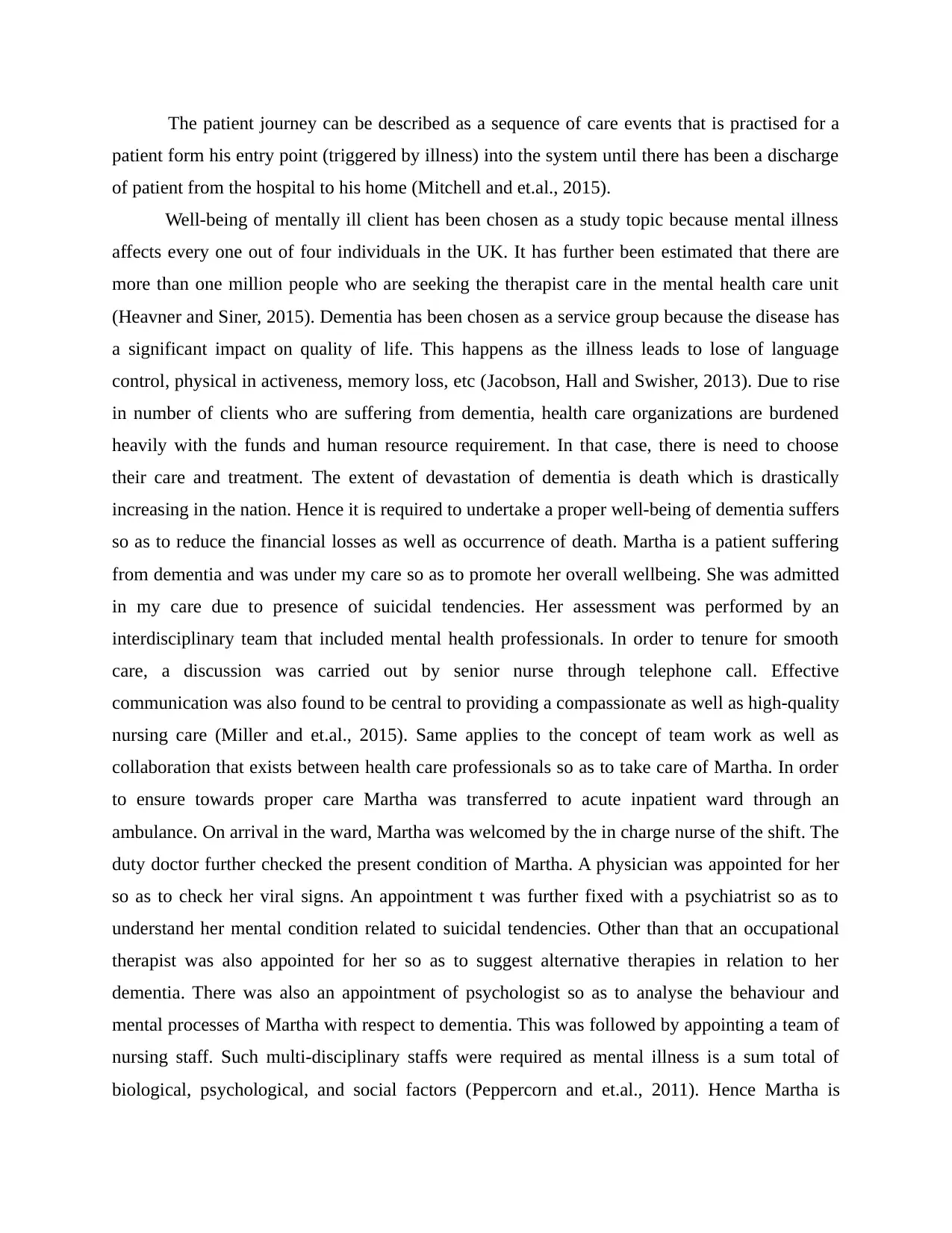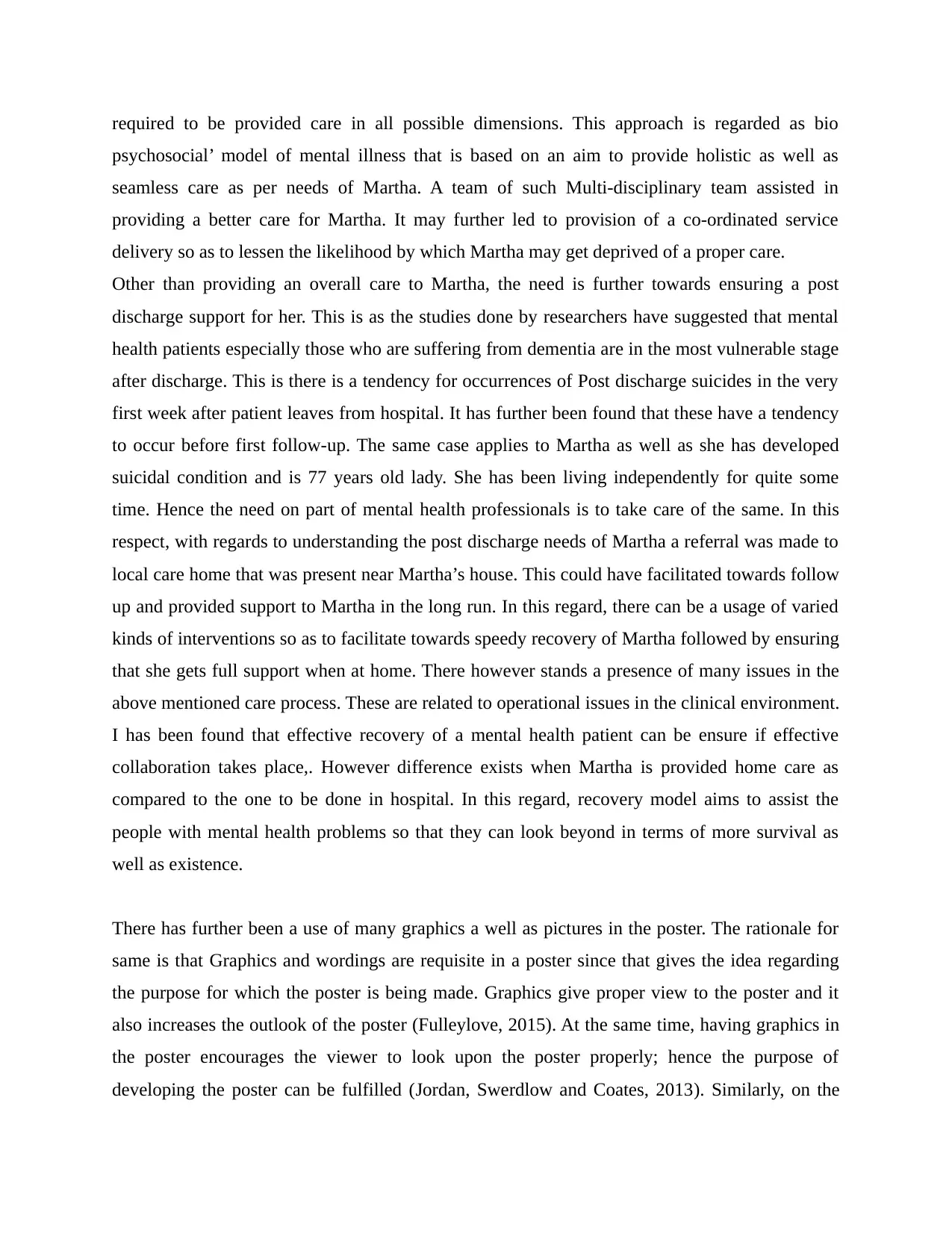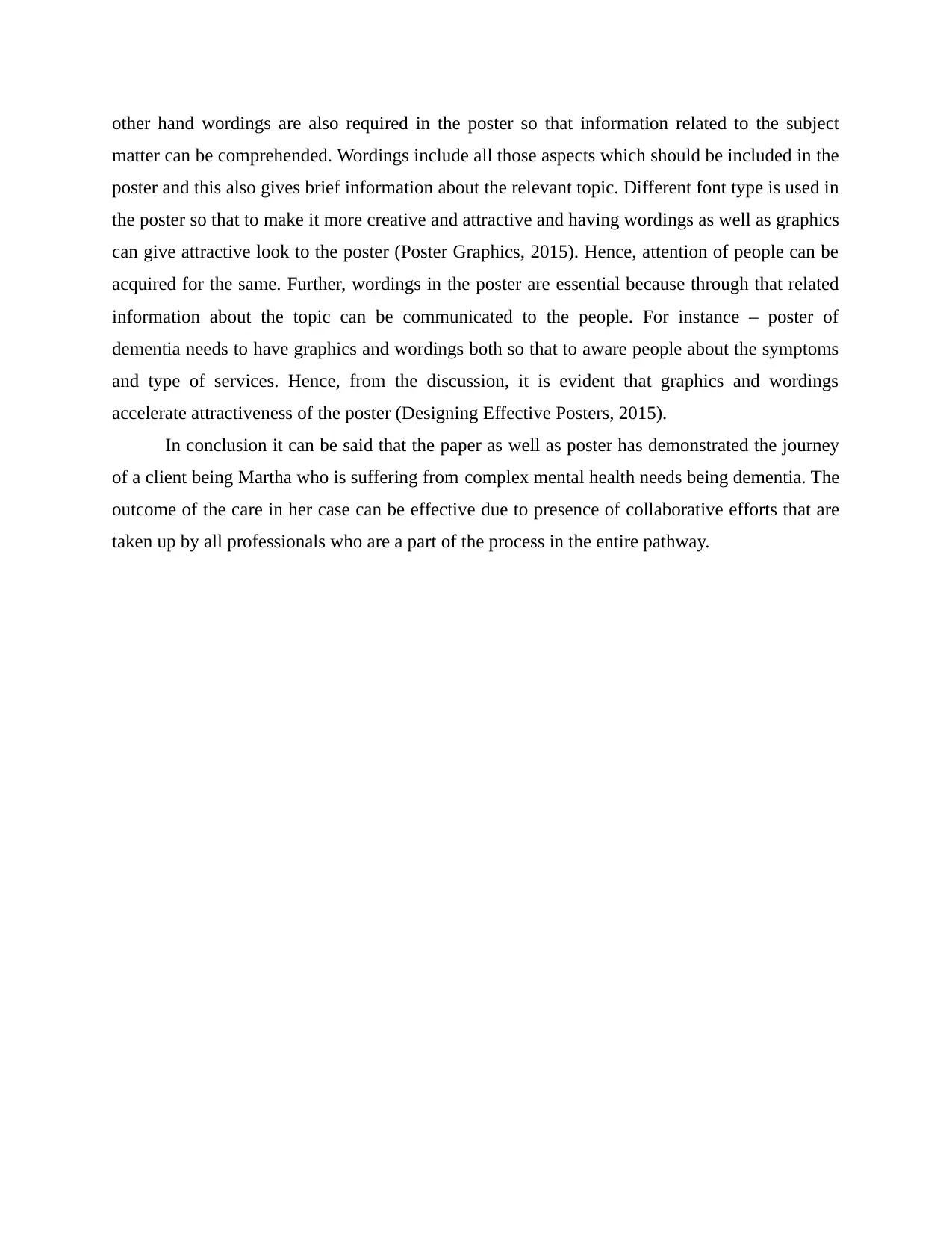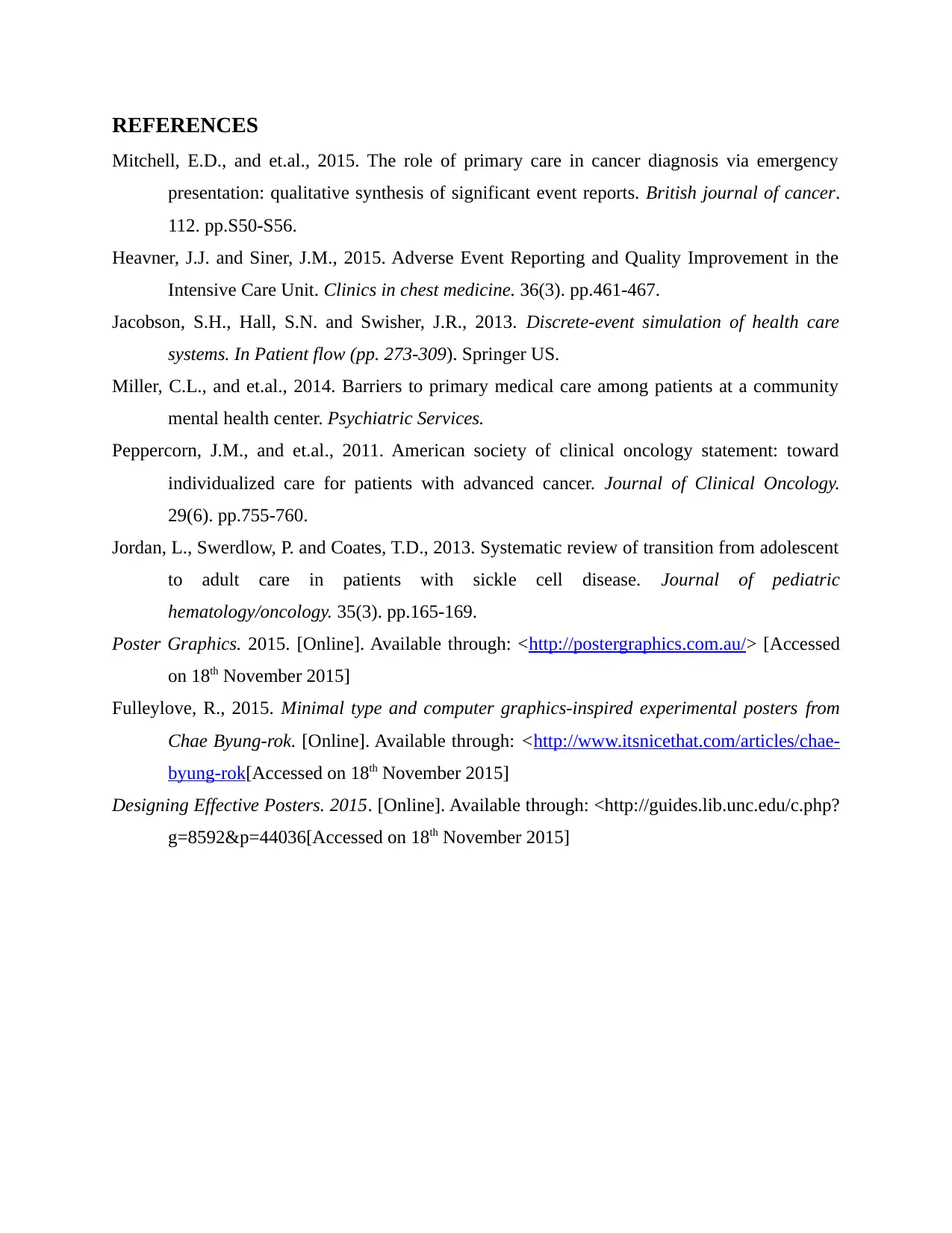Analysis of Martha's Patient Journey and Dementia Care: A Report
VerifiedAdded on 2019/12/03
|5
|1585
|225
Report
AI Summary
This report provides a detailed analysis of a dementia patient's journey, focusing on the case of Martha. It outlines the patient's entry into the healthcare system due to suicidal tendencies, the assessment process involving an interdisciplinary team, and the subsequent care provided in an acute inpatient ward. The report emphasizes the importance of effective communication, teamwork, and collaboration among healthcare professionals. It also highlights the significance of a bio-psychosocial model of care and the need for post-discharge support to prevent adverse outcomes. The report references various studies and discusses the operational issues in the clinical environment. It concludes by emphasizing the effectiveness of collaborative efforts in ensuring positive patient outcomes and the role of graphics and wordings in poster design for dementia awareness.

The patient journey can be described as a sequence of care events that is practised for a
patient form his entry point (triggered by illness) into the system until there has been a discharge
of patient from the hospital to his home (Mitchell and et.al., 2015).
Well-being of mentally ill client has been chosen as a study topic because mental illness
affects every one out of four individuals in the UK. It has further been estimated that there are
more than one million people who are seeking the therapist care in the mental health care unit
(Heavner and Siner, 2015). Dementia has been chosen as a service group because the disease has
a significant impact on quality of life. This happens as the illness leads to lose of language
control, physical in activeness, memory loss, etc (Jacobson, Hall and Swisher, 2013). Due to rise
in number of clients who are suffering from dementia, health care organizations are burdened
heavily with the funds and human resource requirement. In that case, there is need to choose
their care and treatment. The extent of devastation of dementia is death which is drastically
increasing in the nation. Hence it is required to undertake a proper well-being of dementia suffers
so as to reduce the financial losses as well as occurrence of death. Martha is a patient suffering
from dementia and was under my care so as to promote her overall wellbeing. She was admitted
in my care due to presence of suicidal tendencies. Her assessment was performed by an
interdisciplinary team that included mental health professionals. In order to tenure for smooth
care, a discussion was carried out by senior nurse through telephone call. Effective
communication was also found to be central to providing a compassionate as well as high-quality
nursing care (Miller and et.al., 2015). Same applies to the concept of team work as well as
collaboration that exists between health care professionals so as to take care of Martha. In order
to ensure towards proper care Martha was transferred to acute inpatient ward through an
ambulance. On arrival in the ward, Martha was welcomed by the in charge nurse of the shift. The
duty doctor further checked the present condition of Martha. A physician was appointed for her
so as to check her viral signs. An appointment t was further fixed with a psychiatrist so as to
understand her mental condition related to suicidal tendencies. Other than that an occupational
therapist was also appointed for her so as to suggest alternative therapies in relation to her
dementia. There was also an appointment of psychologist so as to analyse the behaviour and
mental processes of Martha with respect to dementia. This was followed by appointing a team of
nursing staff. Such multi-disciplinary staffs were required as mental illness is a sum total of
biological, psychological, and social factors (Peppercorn and et.al., 2011). Hence Martha is
patient form his entry point (triggered by illness) into the system until there has been a discharge
of patient from the hospital to his home (Mitchell and et.al., 2015).
Well-being of mentally ill client has been chosen as a study topic because mental illness
affects every one out of four individuals in the UK. It has further been estimated that there are
more than one million people who are seeking the therapist care in the mental health care unit
(Heavner and Siner, 2015). Dementia has been chosen as a service group because the disease has
a significant impact on quality of life. This happens as the illness leads to lose of language
control, physical in activeness, memory loss, etc (Jacobson, Hall and Swisher, 2013). Due to rise
in number of clients who are suffering from dementia, health care organizations are burdened
heavily with the funds and human resource requirement. In that case, there is need to choose
their care and treatment. The extent of devastation of dementia is death which is drastically
increasing in the nation. Hence it is required to undertake a proper well-being of dementia suffers
so as to reduce the financial losses as well as occurrence of death. Martha is a patient suffering
from dementia and was under my care so as to promote her overall wellbeing. She was admitted
in my care due to presence of suicidal tendencies. Her assessment was performed by an
interdisciplinary team that included mental health professionals. In order to tenure for smooth
care, a discussion was carried out by senior nurse through telephone call. Effective
communication was also found to be central to providing a compassionate as well as high-quality
nursing care (Miller and et.al., 2015). Same applies to the concept of team work as well as
collaboration that exists between health care professionals so as to take care of Martha. In order
to ensure towards proper care Martha was transferred to acute inpatient ward through an
ambulance. On arrival in the ward, Martha was welcomed by the in charge nurse of the shift. The
duty doctor further checked the present condition of Martha. A physician was appointed for her
so as to check her viral signs. An appointment t was further fixed with a psychiatrist so as to
understand her mental condition related to suicidal tendencies. Other than that an occupational
therapist was also appointed for her so as to suggest alternative therapies in relation to her
dementia. There was also an appointment of psychologist so as to analyse the behaviour and
mental processes of Martha with respect to dementia. This was followed by appointing a team of
nursing staff. Such multi-disciplinary staffs were required as mental illness is a sum total of
biological, psychological, and social factors (Peppercorn and et.al., 2011). Hence Martha is
Paraphrase This Document
Need a fresh take? Get an instant paraphrase of this document with our AI Paraphraser

required to be provided care in all possible dimensions. This approach is regarded as bio
psychosocial’ model of mental illness that is based on an aim to provide holistic as well as
seamless care as per needs of Martha. A team of such Multi-disciplinary team assisted in
providing a better care for Martha. It may further led to provision of a co-ordinated service
delivery so as to lessen the likelihood by which Martha may get deprived of a proper care.
Other than providing an overall care to Martha, the need is further towards ensuring a post
discharge support for her. This is as the studies done by researchers have suggested that mental
health patients especially those who are suffering from dementia are in the most vulnerable stage
after discharge. This is there is a tendency for occurrences of Post discharge suicides in the very
first week after patient leaves from hospital. It has further been found that these have a tendency
to occur before first follow-up. The same case applies to Martha as well as she has developed
suicidal condition and is 77 years old lady. She has been living independently for quite some
time. Hence the need on part of mental health professionals is to take care of the same. In this
respect, with regards to understanding the post discharge needs of Martha a referral was made to
local care home that was present near Martha’s house. This could have facilitated towards follow
up and provided support to Martha in the long run. In this regard, there can be a usage of varied
kinds of interventions so as to facilitate towards speedy recovery of Martha followed by ensuring
that she gets full support when at home. There however stands a presence of many issues in the
above mentioned care process. These are related to operational issues in the clinical environment.
I has been found that effective recovery of a mental health patient can be ensure if effective
collaboration takes place,. However difference exists when Martha is provided home care as
compared to the one to be done in hospital. In this regard, recovery model aims to assist the
people with mental health problems so that they can look beyond in terms of more survival as
well as existence.
There has further been a use of many graphics a well as pictures in the poster. The rationale for
same is that Graphics and wordings are requisite in a poster since that gives the idea regarding
the purpose for which the poster is being made. Graphics give proper view to the poster and it
also increases the outlook of the poster (Fulleylove, 2015). At the same time, having graphics in
the poster encourages the viewer to look upon the poster properly; hence the purpose of
developing the poster can be fulfilled (Jordan, Swerdlow and Coates, 2013). Similarly, on the
psychosocial’ model of mental illness that is based on an aim to provide holistic as well as
seamless care as per needs of Martha. A team of such Multi-disciplinary team assisted in
providing a better care for Martha. It may further led to provision of a co-ordinated service
delivery so as to lessen the likelihood by which Martha may get deprived of a proper care.
Other than providing an overall care to Martha, the need is further towards ensuring a post
discharge support for her. This is as the studies done by researchers have suggested that mental
health patients especially those who are suffering from dementia are in the most vulnerable stage
after discharge. This is there is a tendency for occurrences of Post discharge suicides in the very
first week after patient leaves from hospital. It has further been found that these have a tendency
to occur before first follow-up. The same case applies to Martha as well as she has developed
suicidal condition and is 77 years old lady. She has been living independently for quite some
time. Hence the need on part of mental health professionals is to take care of the same. In this
respect, with regards to understanding the post discharge needs of Martha a referral was made to
local care home that was present near Martha’s house. This could have facilitated towards follow
up and provided support to Martha in the long run. In this regard, there can be a usage of varied
kinds of interventions so as to facilitate towards speedy recovery of Martha followed by ensuring
that she gets full support when at home. There however stands a presence of many issues in the
above mentioned care process. These are related to operational issues in the clinical environment.
I has been found that effective recovery of a mental health patient can be ensure if effective
collaboration takes place,. However difference exists when Martha is provided home care as
compared to the one to be done in hospital. In this regard, recovery model aims to assist the
people with mental health problems so that they can look beyond in terms of more survival as
well as existence.
There has further been a use of many graphics a well as pictures in the poster. The rationale for
same is that Graphics and wordings are requisite in a poster since that gives the idea regarding
the purpose for which the poster is being made. Graphics give proper view to the poster and it
also increases the outlook of the poster (Fulleylove, 2015). At the same time, having graphics in
the poster encourages the viewer to look upon the poster properly; hence the purpose of
developing the poster can be fulfilled (Jordan, Swerdlow and Coates, 2013). Similarly, on the

other hand wordings are also required in the poster so that information related to the subject
matter can be comprehended. Wordings include all those aspects which should be included in the
poster and this also gives brief information about the relevant topic. Different font type is used in
the poster so that to make it more creative and attractive and having wordings as well as graphics
can give attractive look to the poster (Poster Graphics, 2015). Hence, attention of people can be
acquired for the same. Further, wordings in the poster are essential because through that related
information about the topic can be communicated to the people. For instance – poster of
dementia needs to have graphics and wordings both so that to aware people about the symptoms
and type of services. Hence, from the discussion, it is evident that graphics and wordings
accelerate attractiveness of the poster (Designing Effective Posters, 2015).
In conclusion it can be said that the paper as well as poster has demonstrated the journey
of a client being Martha who is suffering from complex mental health needs being dementia. The
outcome of the care in her case can be effective due to presence of collaborative efforts that are
taken up by all professionals who are a part of the process in the entire pathway.
matter can be comprehended. Wordings include all those aspects which should be included in the
poster and this also gives brief information about the relevant topic. Different font type is used in
the poster so that to make it more creative and attractive and having wordings as well as graphics
can give attractive look to the poster (Poster Graphics, 2015). Hence, attention of people can be
acquired for the same. Further, wordings in the poster are essential because through that related
information about the topic can be communicated to the people. For instance – poster of
dementia needs to have graphics and wordings both so that to aware people about the symptoms
and type of services. Hence, from the discussion, it is evident that graphics and wordings
accelerate attractiveness of the poster (Designing Effective Posters, 2015).
In conclusion it can be said that the paper as well as poster has demonstrated the journey
of a client being Martha who is suffering from complex mental health needs being dementia. The
outcome of the care in her case can be effective due to presence of collaborative efforts that are
taken up by all professionals who are a part of the process in the entire pathway.
⊘ This is a preview!⊘
Do you want full access?
Subscribe today to unlock all pages.

Trusted by 1+ million students worldwide

REFERENCES
Mitchell, E.D., and et.al., 2015. The role of primary care in cancer diagnosis via emergency
presentation: qualitative synthesis of significant event reports. British journal of cancer.
112. pp.S50-S56.
Heavner, J.J. and Siner, J.M., 2015. Adverse Event Reporting and Quality Improvement in the
Intensive Care Unit. Clinics in chest medicine. 36(3). pp.461-467.
Jacobson, S.H., Hall, S.N. and Swisher, J.R., 2013. Discrete-event simulation of health care
systems. In Patient flow (pp. 273-309). Springer US.
Miller, C.L., and et.al., 2014. Barriers to primary medical care among patients at a community
mental health center. Psychiatric Services.
Peppercorn, J.M., and et.al., 2011. American society of clinical oncology statement: toward
individualized care for patients with advanced cancer. Journal of Clinical Oncology.
29(6). pp.755-760.
Jordan, L., Swerdlow, P. and Coates, T.D., 2013. Systematic review of transition from adolescent
to adult care in patients with sickle cell disease. Journal of pediatric
hematology/oncology. 35(3). pp.165-169.
Poster Graphics. 2015. [Online]. Available through: <http://postergraphics.com.au/> [Accessed
on 18th November 2015]
Fulleylove, R., 2015. Minimal type and computer graphics-inspired experimental posters from
Chae Byung-rok. [Online]. Available through: <http://www.itsnicethat.com/articles/chae-
byung-rok[Accessed on 18th November 2015]
Designing Effective Posters. 2015. [Online]. Available through: <http://guides.lib.unc.edu/c.php?
g=8592&p=44036[Accessed on 18th November 2015]
Mitchell, E.D., and et.al., 2015. The role of primary care in cancer diagnosis via emergency
presentation: qualitative synthesis of significant event reports. British journal of cancer.
112. pp.S50-S56.
Heavner, J.J. and Siner, J.M., 2015. Adverse Event Reporting and Quality Improvement in the
Intensive Care Unit. Clinics in chest medicine. 36(3). pp.461-467.
Jacobson, S.H., Hall, S.N. and Swisher, J.R., 2013. Discrete-event simulation of health care
systems. In Patient flow (pp. 273-309). Springer US.
Miller, C.L., and et.al., 2014. Barriers to primary medical care among patients at a community
mental health center. Psychiatric Services.
Peppercorn, J.M., and et.al., 2011. American society of clinical oncology statement: toward
individualized care for patients with advanced cancer. Journal of Clinical Oncology.
29(6). pp.755-760.
Jordan, L., Swerdlow, P. and Coates, T.D., 2013. Systematic review of transition from adolescent
to adult care in patients with sickle cell disease. Journal of pediatric
hematology/oncology. 35(3). pp.165-169.
Poster Graphics. 2015. [Online]. Available through: <http://postergraphics.com.au/> [Accessed
on 18th November 2015]
Fulleylove, R., 2015. Minimal type and computer graphics-inspired experimental posters from
Chae Byung-rok. [Online]. Available through: <http://www.itsnicethat.com/articles/chae-
byung-rok[Accessed on 18th November 2015]
Designing Effective Posters. 2015. [Online]. Available through: <http://guides.lib.unc.edu/c.php?
g=8592&p=44036[Accessed on 18th November 2015]
Paraphrase This Document
Need a fresh take? Get an instant paraphrase of this document with our AI Paraphraser

1 out of 5
Related Documents
Your All-in-One AI-Powered Toolkit for Academic Success.
+13062052269
info@desklib.com
Available 24*7 on WhatsApp / Email
![[object Object]](/_next/static/media/star-bottom.7253800d.svg)
Unlock your academic potential
Copyright © 2020–2025 A2Z Services. All Rights Reserved. Developed and managed by ZUCOL.





